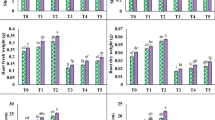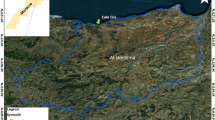Abstract
Tea [Camellia sinensis (L.) O. Kuntze] is an aluminum (Al) hyperaccumulator plant and is commercially important due to its high content of antioxidants. Although Al induced growth is well-known for the plants growing in acid soil, yet the cause underlying the stimulatory effect of Al has not been fully understood. To investigate the possible role of Al in growth induction, we studied morphological, physiological as well as biochemical changes of tea plant under different Al concentrations (0–4,000 μM). In hydroponics, Al (15 μM), enhanced shoot and root growth, but at higher concentrations, it caused oxidative damage which culminated in a cascade of biochemical changes, Al content increased concurrently with the maturity of the leaf as well as stem tissues than their younger counterparts. Hematoxylin staining indicated that Al accumulation started after 6 h of exposure in the tips of young roots and accumulation was dose dependent. The physiological parameters such as pigments, photosynthetic rate, transpiration and stomatal conductance were declined due to Al toxicity. Alteration in activated oxygen metabolism was also evidenced by increasing lipid peroxidation, membrane injury, evolution of superoxide anions and accumulation of H2O2. Contents of phenols initially exhibited an acceleration which gradually plummeted at higher levels whereas total sugar and starch contents decimated beyond 15 μM of Al concentration. Activities of antioxidant defense enzymes were increased with the elevated concentration of Al. Expression of citrate synthase gene was up-regulated in the mature leaves, young as well as old roots simultaneously with increased concentration of Al in those parts; indicating the formation of Al-citrate complex. These results cooperatively specified that Al concentration at lower level promoted growth but turned out to be a stressor at elevated stages indicating the sensitivity of the cultivar (T-78) to Al.










Similar content being viewed by others
References
Abdel-Basset R, Ozuka S, Demiral T, Furuichi T, Sawatani I, Baskin TI, Matsumoto H, Yamamoto Y (2010) Aluminum reduces sugar uptake in tobacco cell cultures: a potential cause of inhibited elongation but not of toxicity. J Exp Bot 61:1597–1610
Aftab T, Khan MMA, Idrees M, Naeem M, Moinuddin (2010) Effects of alluminum exposures on growth, photosynthetic efficiency, lipid peroxidation and artemisinin content of Artemisia annua L. J Phytol 2:23–37
Anoop VM, Basu U, McCammon MT, McAlister-Henn L, Taylor GJ (2003) Modulation of citrate metabolism alters aluminum tolerance in yeast and transgenic canola over-expressing a mitochondrial citrate synthase. Plant Physiol 132:2205–2217
Baligar VC, Smedley MD (1989) Responses of forage grasses to aluminum in solution culture. J Plant Nutr 12:783–796
Barone P, Rosellini D, LaFayette P, Bouton J, Veronesi F, Parrott W (2008) Bacterial citrate synthase expression and soil aluminum tolerance in transgenic alfalfa. Plant Cell Rep 27:893–901
Bowler C, Van Montagu M, Inze D (1992) Superoxide dismutase and stress tolerance. Annu Rev Plant Physiol Plant Mol Biol 43:83–116
Bray HG, Thorpe WV (1954) Analysis of phenolic compounds of interest in metabolism. Methods Biochem Anal 1:27–52
Chance B, Maehly AC (1955) Assay of catalase and peroxidase. In: Colowick SP, Kaplan NO (eds) Methods in enzymology. Academic, New York, pp 764–775
Chen L-S, Qi Y-P, Jiang H-X, Yang L-T, Yang G-H (2010) Photosynthesis and photoprotective systems of plants in response to aluminum toxicity. Afr J Biotechnol 9:9237–9247
Das A, Das S, Mondal TK (2012) Identification of differentially expressed gene profiles in young roots of tea [Camellia sinensis (L.) O. Kuntze] subjected to drought stress using suppression subtractive hybridization. Plant Mol Biol Rep. doi:10.1007/s11105-012-0422-x
Deng W, Luo K, Li Z, Yang Y, Hu N, Wu Y (2009) Over-expression of Citrus junos mitochondrial citrate synthase gene in Nicotiana benthamiana confers aluminum tolerance. Planta 230:355–365
Dixon RA, Steele CL (1999) Flavonoids and isoflavonoids-a gold mine for metabolic engineering. Trends Plant Sci 4:394–400
Duncan DB (1955) Multiple range and multiple F test. Biometrics 11:1–42
Foy CD (1983) The physiology of plant adaptation to metal stress. Iowa State J Res 57:355–391
Ghanati F, Morita A, Yokota H (2005) Effects of aluminum on the growth of tea plant and activation of antioxidant system. Plant Soil 276:133–141
Hedge JE, Hofreiter BT (1962) Determination of reducing sugars and carbohydrates. Methods in carbohydrate chemistry, vol I. Analysis and preparation of sugars, Academic Press, New York, pp 380–398
Jordan CM, DeVay JE (1990) Lysosome disruption associated with hyper-sensitive reaction in the potato-Phytophthora infestans host-parasite interaction. Physiol Plant Pathol 36:221–236
Kinraide TB (1993) Aluminum enhancement of plant growth in acid rooting media. A case of reciprocal alleviation of toxicity by two toxic cations. Physiol Plant 88:619–625
Konishi S (1992) Promotive effects of aluminium on tea plant growth. Jpn Agric Res Q 26:26–33
Konishi S, Miyamato S, Taki T (1985) Stimulatory effects of aluminum on tea plants grown under low and high phosphorus supply. Soil Sci Plant Nutr 31:361–363
Li C, Xu H, Xu J, Chun X, Ni D (2011) Effects of aluminum on ultrastructure and antioxidant activity in leaves of tea plant. Acta Physiol Plant 33:973–978
Lichtenthaler HK (1987) Chlorophylls and carotenoids: pigments of photosynthetic biomembranes. Method Enzymol 148:350–382
Ma JF (2000) Role of organic acids in detoxification of aluminum in higher plants. Plant Cell Physiol 41:383–390
Ma JF, Hiradate S, Nomoto K, Iwashita T, Matsumoto H (1997) Internal detoxification mechanism of Al in Hydrangea. Plant Physiol 113:1033–1039
Ma JF, Taketa S, Yang ZM (2000) Aluminum tolerance genes on the short arm of chromosome 3R are linked to organic acid release in triticale. Plant Physiol 122:687–694
Ma JF, Ryan PR, Delhaize E (2001) Aluminum tolerance in plants and the complexing role of organic acids. Trends Plant Sci 6:273–278
Matsumoto H (2000) Cell biology of aluminum toxicity and tolerance in higher plants. Int Rev Cytol 200:1–46
Matsumoto H, Hirasawa E, Morimura S, Takahashi E (1976) Localization of aluminum in tea leaves. Plant Cell Physiol 17:627–631
Mondal TK, Bhattacharya A, Laxmikumaran M, Ahuja PS (2004) Recent advance in tea Biotechnology. Plant Cell Tissue Org Cult 75:795–856
Morita A, Horie H, Fujii Y, Takatsu S, Watanabe N, Yagi A, Yokota H (2004) Chemical forms of aluminum in xylem sap of tea plants (Camellia sinensis L.). Phytochemistry 65:2775–2780
Morita A, Yanagisawa O, Takatsu S, Maeda S, Hiradate S (2008) Mechanism for the detoxification of aluminum in roots of tea plant (Camellia sinsensis (L) Kuntze). Phytochemistry 69:147–153
Murti GSR, Sarma VAK, Rengasamy P (1974) Spectrophotometric determination of aluminum with aluminon. Indian J Technol 12:270–271
Nagata T, Hayatsu M, Kosuge N (1992) Identification of aluminum forms in tea leaves by 27Al NMR. Phytochemistry 31:1215–1218
Nakano Y, Asada K (1981) Hydrogen peroxide is scavenged by ascorbate specific peroxidase in spinach chloroplasts. Plant Cell Physiol 22:867–880
Nanjo T, Kobayashi M, Yoshiba Y, Kakubar Y, Yamaguchi Y, Shinozaki K, Shinozaki K (1999) Antisense suppression of the proline degradation improves tolerance to freezing and salinity in Arabidopsis thaliana. FEBS Lett 461:205–210
Ohkawa H, Ohishi N, Yagi K (1979) Assay for lipid peroxides in animal tissues by thiobarbituric acid reaction. Anal Biochem 95:351–358
Ownby JD (1993) Mechanisms of reaction of hematoxylin with aluminum-treated wheat roots. Physiol Plant 87:371–380
Peixoto PH, Da Matta FM, Cambraia J (2002) Responses of the photosynthetic apparatus to aluminum stress in two sorghum cultivars. J Plant Nutr 25:821–832
Pereira LB, Tabaldi LA, Goncalves JF, Juckeoski GO, Pauletto MM, Weis SN, Nicoloso FT, Bocher D, Rocha JBT, Schetinger MRC (2006) Effect of Aluminum on δ-aminolevulinic acid dehydratase (ALA-D) and the development of cucumber (Cucumis sativus). Environ Exp Bot 57:106–115
Pereira LB, de A Mazzanti CM, Cargnelutti D, Rossato LV, Gonçalves JF, Calgaroto N, Dressler V, Nicoloso FT, Federizzi LC, Morsch VM, Schetinger MRC (2011) Differential responses of oat genotypes: oxidative stress provoked by aluminum. Biometals 24:73–83
Polle E, Konzak CF, Kittrick JA (1978) Visual detection of aluminum tolerance levels in wheat by hematoxylin staining of seedling roots. Crop Sci 18:823–827
Poschenrieder C, Gunsé B, Corrales I, Barceló J (2008) A glance into aluminum toxicity and resistance in plants. Sci Total Environ 400:356–368
Ruan J, Ma L, Shi Y (2006) Aluminum in tea plantations: mobility in soils and plants, and the influence of nitrogen fertilization. Environ Geochem Health 28:519–528
Sachs MM, Ho T-HD (1986) Alteration of gene expression during environmental stress in plants. Annu Rev Plant Physiol 37:363–376
Sagisaka S (1976) The occurrence of peroxide in a perennial plant Populas gelrica. Plant Physiol 57:308–309
Salin ML (1988) Toxic oxygen species and protective systems of the chloroplast. Physiol Plantarum 72:681–689
Samac DA, Tesfaye M (2003) Plant improvement for tolerance to aluminum in acid soils—a review. Review of Plant Biotechnology and Applied Genetics. Plant Cell Tissue Org Cult 75:189–207
Schier GA, McQuattie CJ (2002) Stimulatory effects of aluminum on growth of sugar maple seedlings. J Plant Nutr 25:2583–2589
Shen R, Ma JF (2001) Distribution and mobility of aluminum in an Al-accumulating plant, Fagopyrum esculentum Moench. J Exp Bot 52:1683–1687
Shen H, He LF, Sasaki T, Yamamoto Y, Zheng SJ, Ligaba A, Yan XL, Ahn SJ, Yamaguchi M, Sasakawa H, Matsumoto H (2005) Citrate secretion coupled with the modulation of soybean root tip under aluminum stress. Up-Regulation of transcription, translation, and threonine-oriented phosphorylation of plasma membrane H+-ATPase. Plant Physiol 138:287–296
Singh S, Eapen S, D’Souza SF (2006) Cadmium accumulation and its influence on lipid peroxidation and antioxidative system in an aquatic plant, Bacopa monnieri L. Chemosphere 62:233–246
Taylor GJ (1991) Current views of the aluminum stress response: the physiological basis of tolerance. Curr Top Plant Biochem Physiol 10:57–93
Tolrà R, Vogel-Mikuš K, Hajiboland R, Kump P, Pongrac P, Kaulich B, Gianoncelli A, Babin V, Barceló J, Regvar M, Poschenrieder C (2011) Localization of aluminium in tea (Camellia sinensis) leaves using low energy X-ray fluorescence spectro-microscopy. J Plant Res 124:165–172
Upadhyaya H, Panda SK (2004) Responses of Camellia sinensis to drought and rehydration. Biol Plantarum 48:597–600
Wada H, Koshiba T, Matsui T, Sato M (1998) Involvement of peroxidase in differential sensitivity to γ-radiation in seedlings of two Nicotiana species. Plant Sci 132:109–119
Watanabe T, Osaki M, Yoshihara T, Tadano T (1998) Distribution and chemical speciation of aluminum in the Al accumulator plant, Melastoma malabathricum L. Plant Soil 201:165–173
Weckx JEJ, Clijsters HMM (1996) Oxidative damage and deference mechanisms in primary leaves of Phaseolus vulgaris. Physiol Plant 96:506–512
Acknowledgment
The authors are thankful to late Dr. R S Saha, Scientist, Darjeeling Tea Research Centre, Tea Board, Darjeeling, West Bengal for providing the tea plantlets and Mr. Pratap Subba for his technical help. The financial assistance from Tea Board, Govt of India is also acknowledged.
Author information
Authors and Affiliations
Corresponding author
Additional information
Mainaak Mukhopadyay and Pranay Bantawa contributed equally to this study.
Rights and permissions
About this article
Cite this article
Mukhopadyay, M., Bantawa, P., Das, A. et al. Changes of growth, photosynthesis and alteration of leaf antioxidative defence system of tea [Camellia sinensis (L.) O. Kuntze] seedlings under aluminum stress. Biometals 25, 1141–1154 (2012). https://doi.org/10.1007/s10534-012-9576-0
Received:
Accepted:
Published:
Issue Date:
DOI: https://doi.org/10.1007/s10534-012-9576-0




